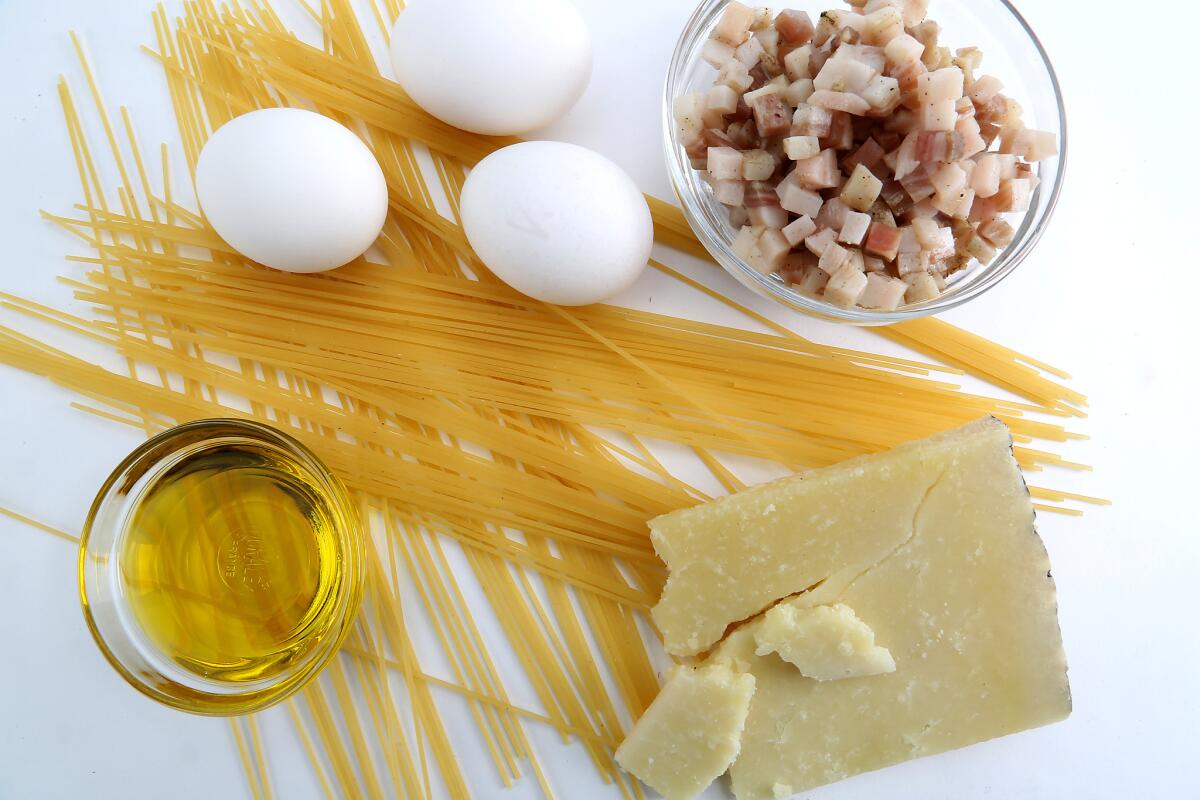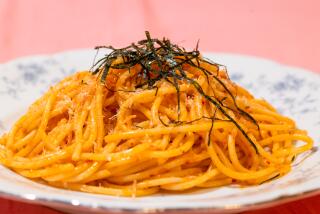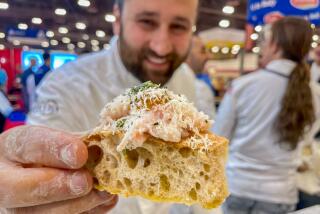Lost pasta brand sparks Test Kitchen pot-boiler to find best dried spaghetti

- Share via
For a busy weekday cook, having a good dried spaghetti in the pantry is about 90% of having dinner made. Dress it with butter and Parmigiano Reggiano, or chopped fresh tomatoes and olive oil, and you have a memorable meal with little more than the time and effort it took to boil water.
When my go-to daily spaghetti brand disappeared from store shelves, I was bereft, robbed of the foundation for a dozen easy meals. Fortunately, the L.A. Times Test Kitchen was there to help. I bought 10 supermarket brands of spaghetti, all of them priced less than $4 a pound, and then we cooked them.
In the end, I found my replacement pasta, but there were some significant surprises along the way, including a gluten-free that was nearly as good as our favorites.
First, let’s specify that what we’re talking about is dried spaghetti noodles made from wheat, water and not much else (some brands both domestic and Italian add vitamins and minerals for the American market). Egg pastas that have been dried are not the same thing.
But even with such a simple ingredient, there is good and not-so-good. The difference is not what you might expect: The actual flavor of the noodles we tasted varied little. Tasting naked spaghetti is like differentiating among various degrees of beige.
When the differences really showed up was after we dressed the noodles with a little inexpensive bottled sauce. Because the most important thing about a pasta is how it carries flavor, and that can vary dramatically. Stirred with the same jarred sauce, some spaghetti tasted simple and bland while others tasted almost like something we’d make at home.
When we went back over the spaghetti brands we liked best, the thing we found in common was a rough, almost pitted texture on the uncooked noodles. This is what carries the sauce and allows you to get the full effect of it rather than just whatever liquid managed to cling to the noodle.
Which spaghetti did we like best? The Garofalo sold at Costco and Amazon.com ($3.81 per pound), Whole Foods’ store-brand 365 “organic” ($1.49) and supermarket staple Barilla ($1.49).
That gluten-free? It was also from Barilla ($3.29). It had terrific bite and only a little of the mealy texture you might expect from a dried noodle made without the benefit of gluten from hard wheat. The package reads, “Made with corn and rice.”
One thing we found curious was the difference between two seemingly similar noodles, one we bought at Trader Joe’s labeled Lucio Garofalo (99 cents) and the more expensive Costco brand that we liked, labeled simply Garofalo.
When you read the fine print, they both had the same simple ingredients (semolina and durum wheat), but more significantly they both gave the same address for the manufacturer (indeed, the Garofalo website lists the full name as Pastificio Lucio Garofalo).
But while the Trader Joe’s brand wasn’t bad, it certainly wasn’t as good as the other Garofalo. And when we inspected the raw noodles, we could see why: The Trader Joe’s version was nearly smooth, while the Costco/Amazon version was the most pitted of any of the pastas we tested.
We’ve done these tastings a couple of times over the years with a mix of high-end and everyday brands. The Latini brand had won both. It was certainly a terrific pasta, but it seems to have disappeared (one importer says the brand was sold and is no longer making pasta at all). Rustichella d’Abruzzo did well both times too, but with it costing as much as $8 per pound, it may be a bit pricey for everyday use.
After all, there’s no need to break the bank for what should be the daily luxury of a simple, well-prepared plate of pasta.
Follow me on Twitter @russ_parsons1
More to Read
Eat your way across L.A.
Get our weekly Tasting Notes newsletter for reviews, news and more.
You may occasionally receive promotional content from the Los Angeles Times.











